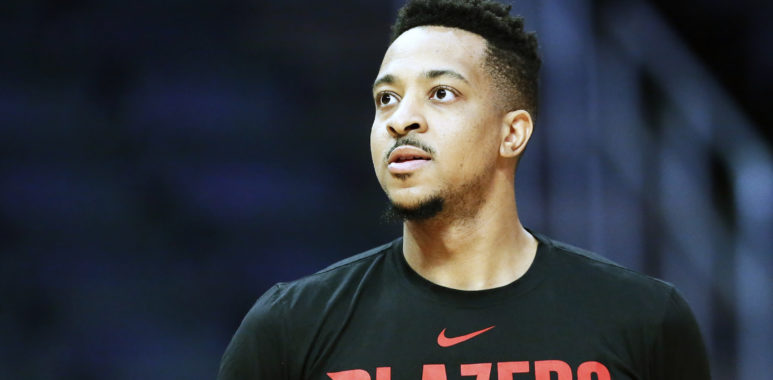
3 questions the Trail Blazers must answer to beat the Thunder
The Trail Blazers somehow avoided disaster down the stretch and locked up the 3-seed in the Western Conference playoffs, despite injuries to CJ McCollum and Jusuf Nurkic. Even after accounting for the loss of their starting center, the Blazers face several major questions as they head into the postseason. Here are three questions they must answer if they hope to beat the Thunder:
1. What are they going to do about athletic centers?
The Blazers have a problem guarding athletic centers, especially guys who can catch lob passes around the rim. It’s a symptom of their conservative defensive scheme that favors corralling a ballhandler into the mid-range. Basketball Index’s team grades puts Portland’s bigs in the 29th percentile for interior defense.
The Blazers defensive woes have been compounded by Nurkic’s injury. Enes Kanter does not have the mobility to defend in space against rangier players and the Blazers wing defenders have not shown the capacity to compensate.
The consequence: JaVale McGee and some dude named Caruso, who looks like your uncle’s 2k create-a-player, are pick-and-rolling your defense to death down the stretch of a must-win game:
And now the Blazers are headed into a playoff series with Russell Westbrook and Steve Adams. I guess the alternative was Rudy Gobert, which somehow might have been worse. This must be addressed.
2. Will CJ McCollum be back to his usual form?
McCollum missed 10 games near the end of the season with a knee strain, before returning to play games 80 and 81. Blazers coach Terry Stotts said the team wanted McCollum to get a couple games in before the playoffs, presumably to combat any effects of rust and also adjust to playing without Nurkic.
As near as I can tell there’s no empirical evidence substantiating the concept of “rust” but, well, CJ looked rusty. He shot a combined 8-for-26 from the field in his two tune-up games and scored only 20 combined points — he’s averaging 21 points on 46 percent shooting per game for the season.
Captain Obvious time: He’ll have to do better if the Blazers want to beat the Thunder.
McCollum averaged 25 points per game on 61 percent True Shooting last year in the playoffs and the Blazers STILL got swept out by the Pelicans. Without Nurkic, anything less than 100 percent CJ is going to be a big problem.
But there’s another hidden problem here: McCollum shot only 34 percent on 3-pointers for the first two months of the season, well below his career average of about 40 percent. Three-point accuracy is one of the most volatile stats, and he rebounded to shoot 41 percent from January to the end of the season, so there’s a good chance his extended slump was just noise.
But there’s still a niggling concern in the back of my head that the injury may have caused enough of a decline in CJ’s in-game fitness to re-start the early season slump.
3. Can Damian Lillard and the other guards hit 3-pointers?
Jusuf Nurkic added a new dimension to the Blazers offense with his playmaking. Last season the Pelicans, in the first couple games of the series at least, played an “anyone but Lillard” gambit and basically ceded open 3-pointers to guys like Maurice Harkless and Al-Farouq Aminu. In game one the supporting cast did not deliver:
Yeah, but who's taking those shots? Everyone not named CJ/Dame was 4-for-20 on 3-pointers. Will that number improve decidedly in 4 of the next 6 games?
— Eric Griffith (@EricG_NBA) April 15, 2018
Aminu recovered and had a good series for the Blazers, but he finished as the only Portland player to both attempt and make triples at a higher rate during the regular season:
Last year only one Blazers attempted threes at a higher rate and made them at a higher rate in the playoffs than in the regular season: Al-Farouq Aminu.
Who else will step up this year? And can he also play solid defense? pic.twitter.com/UcmxAiA51l
— Eric Griffith (@EricG_NBA) April 11, 2019
The pressure had an effect on Lillard, who saw a massive drop in free throw rate and shot a miserable 30 percent on nine 3-pointers per 100 possessions. With no teammates, other than Aminu, truly exploiting the Pelicans defense it was too easy to shut down Lillard and, consequently, the Blazers.
The pressure on Lillard was partially mitigated this year by adding a new wrinkle to Nurkic’s offense — stick him on the elbow and go to town making plays. It worked. Nurkic’s playmaking opened options for cutting and secondary actions instead of just swinging the ball to unreliable open shooters.
Without Nurkic’s playmaking, however, the Blazers are now likely going to face defenses that will cede wide open triples all night long to secondary players. Can they find a way to replicate Nurkic’s playmaking? Or will secondary player step up and take advantage of the holes in the defense?
